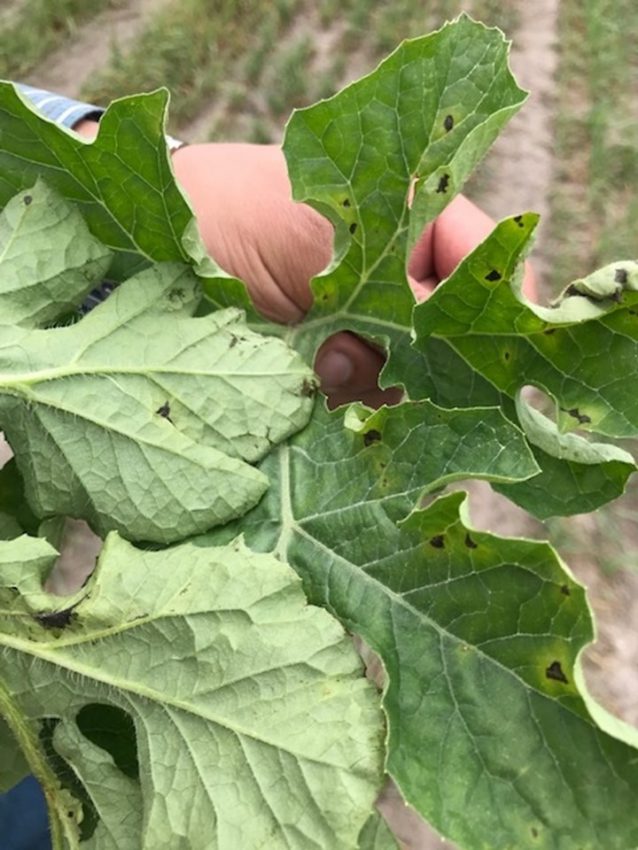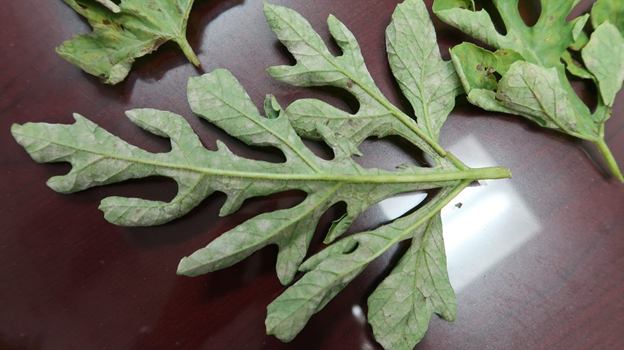Bob Hochmuth, Regional Specialized Extension Agent- Vegetable Crops – Published April 16, 2023
Welcome to the 2023 growing season, weekly issue of the UF/IFAS Extension Suwannee Valley Watermelon Crop Update. These updates are summarized by Bob Hochmuth, Regional Specialized Extension Agent- Vegetable Crops, with input from Suwannee Valley Extension Agents: Mark Warren (Levy), Tyler Pittman (Gilchrist), Tatiana Sanchez (Alachua), Luke Harlow (Bradford), Jay Capasso (Columbia), Dan Fenneman (Madison), Keith Wynn (Hamilton), Emily Beach (Lafayette), Jim Devalerio (Union), De’Anthony Price (Jefferson), Bob Hochmuth (for vacant Suwannee position), Kevin Athearn (RSA-Agri- business), and Sudeep Sidhu (RSA- Water Resources). If you know someone who wants to be added to this weekly notice, contact your Extension Agent or Mark Warren (352-949-8288) if you want to be added to the regional watermelon group text app.
–
Caution about Vydate Applications
We have been getting a few questions regarding applications of Vydate for nematode management and possibly helping with Fusarium control. Vydate is a systemic nematicide/insecticide and can be useful early in the year (particularly at or before planting) for nematode management according to UF/IFAS research, but the benefits of late-season nematicide application for nematode management and fusarium management are not established. Beyond the debate of whether this would be an effective strategy or not, we are alerting anyone who is considering this recommendation that the Vydate L label has the following restriction under the Environmental Hazards Section, “This product is highly toxic to bees exposed to direct treatment or residues on blooming crops or weeds. Do not apply this product or allow it to drift to blooming crops or weeds if bees are foraging the treatment area”. A systemic pesticide like Vydate should not be applied during this time of the season, when we have watermelon flowers and with bee foraging and pollination occurring. (Bob Hochmuth and Zane Grabau)
–
Disease in the Field
Bacterial Leaf Spot
At the end of this past week, we detected some bacterial leaf spot on watermelon leaves. This is not unexpected as the early part of last week was cold, rainy and windy, all very good conditions for bacterial leaf spot to infect. As in past updates, if you see bacterial leaf spot, we recommend adding a low rate of copper (0.5 lbs/A) to your spray program. See photo below (Bob Hochmuth and Shivendra Kumar).
–
Gummy Stem Blight and Powdery Mildew Strategies
Even though we have not seen much disease activity up to this point, we are becoming more concerned about gummy stem blight and powdery mildew. This is the time of the season to be on the lookout for both of these diseases. Of course, most fields do not have gummy or powdery yet, but both of these diseases are serious enough that we want to be proactive. Curing these diseases after they appear is much more difficult than preventing them. Since the strategy of a spray program needs to be laid out well in advance, we are sharing our thoughts and considerations.
We have some guidance to share if gummy stem blight is a concern in your fields. If gummy stem blight is not present in your fields yet, this would be the best time to use Miravis Prime as it is better positioned ahead of infection, not after gummy has gotten well established. Miravis Prime has some activity on powdery mildew too, but we encourage you to add a material like Quintec or Procure to Miravis Prime to stay ahead of powdery mildew. This could be followed by mancozeb and possibly tebuconazole plus the alternating powdery mildew material (Quintec or Procure). UF/IFAS consistently ranks Inspire Super in the top performer for gummy stem blight as a curative spray, but it has a 7-day preharvest interval (PHI). So, as you approach harvest, remember you need 7 days before your harvest. However, once you get into harvest season, and if you have already sprayed Inspire Super or are at less than 7 days to next harvest, what should you use? In those cases, Aprovia Top would be a good option. Aprovia Top has performed very similarly to Inspire Super in most trials and has a 0-day PHI on the label. The main caution is that both Inspire Super and Aprovia Top have FRAC Group 3 fungicides in their ingredients, so we want to minimize the number of applications of these two in rotation. Keep in mind Aprovia Top is a great option, if needed once you start the harvest season. A final note regarding spray programs once harvests start, pay close attention to pre-harvest intervals (PHI). Common rotations after harvests begin will include the following materials: Mancozeb (Manzate, Penncozeb) which has a PHI of 5 days, Quintec 3-day PHI, and Procure 0-day PHI. Aprovia Top has a 0-day PHI and Miravis Prime has a 1-day PHI. But other materials like tebuconozole, Inspire Super, and Luna Experience all have a 7-day PHI, so be alert to the PHI and your harvesting schedule and food safety records. Because Inspire Super and Aprovia Top both share difenoconazole, you need to remember not to exceed the 0.46 lbs a.i/A/year. (Bob Hochmuth, Tatiana Sanchez-Jones, and Mathews Paret)
- 2024 Watermelon Season Wrap Up - June 21, 2024
- Weekly Watermelon Update – June 3 - June 7, 2024
- Weekly Watermelon Update #10 – May 20 - May 24, 2024


